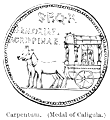Carpentum
A cart; also a rectangular twowheeled carriage, enclosed, and with an arched or sloping
cover overhead.
The carpentum was used to convey the Roman matrons in the public festal processions; and, as
this was a high distinction, the privilege of riding in a carpentum on such occasions was
allowed to particular women by special grant of the Senate. This was done on behalf of
Agrippina, who availed herself of the privilege so far as even to enter the Capitol in her
carpentum (
Tac. Ann. xii. 42). A
 |
|
Carpentum. (Medal of Caligula.)
|
medal was struck (see illustration) to commemorate this decree of the Senate in her
favour. When Claudius celebrated his triumph at Rome, he was followed by his empress,
Messalina, in her carpentum (
Claud. 17).
This carriage contained seats for two, and sometimes for three persons, besides the coachman
(
Liv.i. 34). It was commonly drawn by a pair of mules (
carpentum mulare), but more rarely by oxen or horses, and sometimes by four
horses like a
quadriga. For grand occasions it was very richly adorned.
Agrippina's carriage, as above represented, shows painting or carving on the panels, and the
head is supported by
Caryatides (q.v.) at the
four corners. The convenience and stateliness of the carpentum were also assumed by
magistrates, and by men of luxurious habits, or those who had a passion for driving. When
Caligula instituted games and other solemnities in honour of his deceased mother, Agrippina,
her carpentum went in the procession (
Calig. 15).
Carpenta, or covered carts, were much used by the Britons, and by the Gauls, the Cimbri, the
Allobroges, and other Northern nations (
Flor.i. 18et al.). These, together with the carts of the more common form, including
baggage-wagons, appear to have been comprehended under the term
carri or
carra, which is the Keltic name with a Latin termination. The Gauls and
Helvetii took a great multitude of them on their military expeditions; and, when they were
encamped, arranged them in close order, so as to form extensive lines of circumvallation
(
B. G. i. 24, 26).
The agricultural writers use
carpentum to denote either a common cart
or a cart-load—e. g.
xxiv stercoris carpenta (Pallad. x. 1).





